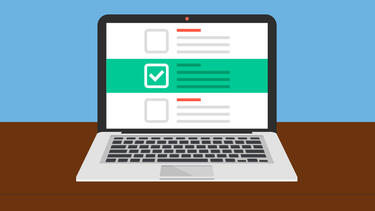When Prompting People to Make a Choice, the Consequence of Not Choosing Matters
People often neglect to make decisions about issues ranging from 401(k) enrollment to organ donation. One way to address this neglect is to require people to actively choose. But in a new study, Yale SOM’s James Choi and his colleagues found that the implicit default—what happens if people refuse to make an active choice despite the requirement—affects whether they make a choice.

By Roberta Kwok
When faced with a decision, people often dither, procrastinate, and never make a choice at all. For instance, many employees don’t sign up for 401(k) plans despite the financial benefits. Similarly, people often don’t indicate whether they’d like to donate their organs upon death. As a result, the default option gets implemented for many.
“It’s not necessarily that they think the default choice is the best for them,” says James Choi, a professor of finance at Yale SOM. “It’s just that they haven’t gotten around to making the choice, or it falls off their radar screen.”
In a recent study, Choi’s team investigated the effects of requiring employees to actively select an option in their prescription benefit plan. Workers at a company had to affirmatively indicate whether they wanted to pick up their long-term maintenance prescriptions at a retail pharmacy or have these medications mailed to their home, which was less costly and more convenient for most employees. The researchers found that this active choice regime substantially increased the fraction of medications for which people picked home delivery relative to the previous regime, where pharmacy pickup was the default.
However, the implicit default—what was implemented if an employee refused to make an active choice—affected whether the employee did in fact actively choose. In the studied setting, the implicit default was to pick up prescriptions at the pharmacy without insurance subsidies. The team found that employees who would save more money through insurance subsidies, and therefore had a larger incentive to make an active decision, were more likely to do so.
“People are responsive to these economic incentives to make an active choice,” says Choi, who collaborated with John Beshears at Harvard Business School, David Laibson at Harvard University, and Brigitte Madrian at the Brigham Young University Marriott School of Business.
Read the study: “Active choice, implicit defaults, and the incentive to choose”
In an earlier study, Choi and his collaborators tested whether employees at a financial company were more likely to enroll in a 401(k) plan if prodded to make a choice. The results suggested that this strategy did increase enrollment relative to a regime where non-enrollment was the default, but the researchers didn’t know if the effect held true for other types of decisions or firms.
So his team worked with the pharmacy benefit management company Express Scripts to study an active choice intervention at a retail firm. (One of the researchers, David Laibson, served on Express Scripts’ scientific advisory board.) The default option was for employees to pick up recurring medications at the drugstore. Before the intervention, few workers opted for home delivery.
Home delivery offered benefits: It cost less for the employee, company, and pharmacy benefit manager. It also reduced the hassle of obtaining medications. Other research by Choi has illuminated the power of defaults—for example, enrolling employees into 401(k)s by default causes more of them to save for retirement. But the firm couldn’t make home delivery the default because it wasn’t right for everyone. For instance, some people may not have been able to receive packages in the mail securely.
“You couldn’t just say, ‘By default, all of you are now going to be switched to home delivery,’” Choi says. “We thought an active choice intervention was called for.”
Express Scripts told about 23,000 employees that they needed to actively choose between store pickup and home delivery for each medication; the instructions touted the benefits of the latter method. If a worker didn’t indicate a decision, the default was store pickup, but after the first two claims for that drug, insurance subsidies would be cut off until the employee actively chose an option.
Choi’s team then tracked people’s choices over the next year. For comparison, the researchers analyzed a control group of about 20,000 workers at the same firm during the year before the intervention.
In the control group, people chose home delivery for only 6% of their medications. But in the targeted group, employees chose home delivery for 42% of their drugs.
Although it is in principle possible that the increase in home delivery was due to people simply being persuaded after learning more about its benefits, the fact that uptake didn’t rise much until insurance subsidies were about to be cut off “points to active choice being the critical driver,” the team writes.
Nineteen percent of workers in the intervention group still refused to choose. These people tended to have small out-of-pocket payments even without insurance coverage. For instance, when an employee stood to save more than $68 per drug claim with insurance, a choice wasn’t made only 15% of the time. But when a worker received no insurance subsidy for the drug (because its unsubsidized cost was very low), 28% avoided indicating a decision.
People who picked home delivery potentially saved an average of about $40 per drug class per year. The active choice program cut the retail company’s and employees’ collective costs by about $700,000 annually, the researchers estimate.
While active choice interventions appear to be effective, organizations need to carefully consider how they will enforce the requirement to choose, Choi says. Some might want to offer rewards for making a decision rather than instituting a penalty. And if the penalty is dire, firms should think about whether they’re prepared to follow through when a worker misses the decision deadline.
“You might start feeling squeamish and not be willing to let the executioner’s sword fall,” Choi says.